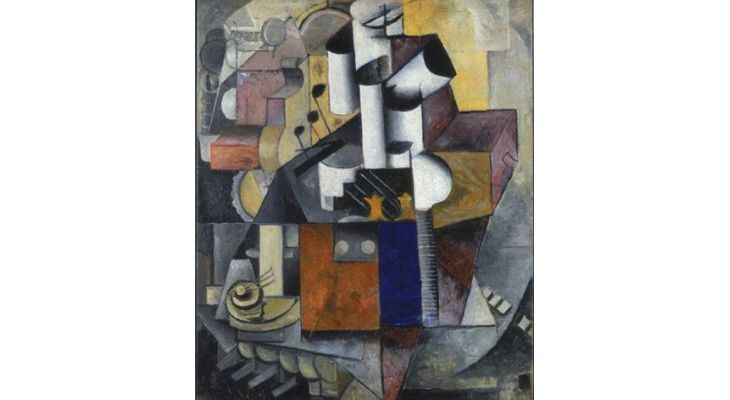Kazimir Malevich’s evocative painting, “Lamp, Musical Instruments,” a masterful oil on canvas sized at 87.5 x 73.5 x 5cm, finds its home in the revered Stedelijk Museum in Amsterdam, Netherlands. Painted in 1913, during an epoch of profound artistic exploration in Europe, the work subtly weaves together the interplay of musical instruments and abstract symbols. The specificity of these symbols remains a tantalizing enigma, given the limited information available. Yet, even in the absence of a defined narrative, Malevich’s work, steeped in its abstract and geometric essence, resonates with viewers, offering a harmonious blend of form and potential musical symphony.
Rooted in the fervor of the early 20th century’s artistic innovation, “Lamp, Musical Instruments” echoes the undercurrents of several transformative art movements of its time, most notably Suprematism. As a pivotal figure in the Suprematism movement, Malevich championed a bold abstraction marked by geometric shapes and purity of form. This painting is no exception, epitomizing his commitment to Suprematist ideals. The presence of musical instruments, intertwined with abstract elements, forges an intriguing bridge between music and visual art. This amalgamation speaks volumes of the intertwined relationship of varied artistic mediums and Malevich’s personal inclination or statement towards music.
Lastly, understanding “Lamp, Musical Instruments” in the broader historical context offers invaluable insights. The painting stands as a testament to a period characterized by radical shifts in artistic expression, from Cubism to Futurism and, notably, Suprematism. While the resonance of music and its symbiotic relationship with art is a recurring theme throughout history, Malevich’s rendition is distinctive in its abstracted and geometric portrayal. His legacy, cemented by such works, continues to influence the trajectory of abstract art, with echoes of his style evident in the works of subsequent artists, such as Piet Mondrian. For a comprehensive appreciation of this artwork, one is encouraged to immerse themselves in the ambiance of the Stedelijk Museum or seek the counsel of art connoisseurs.
Kazimir Malevich produced a number of Cubist artworks in the year of 1913, one of which was titled Lamp, Musical Instruments. The artist took on a good number of different styles across his career, though he remains most famous for his abstract shapes in simple black and white tones.
Malevich worked in a particular style of Cubism in which elements would be mixed around in new combinations in a manner which made it hard to identify the different parts of the scene. Malevich was influenced by other Europeans who were working extensively within the Cubist movement and their passion for it seemed to rub off on the Russian. He would re-visit the approach several times before then moving on again and trying out other ideas as he continued to search for his own preferred style. Eventually, it would be abstract art that inspired him the most and it is those artworks that can be considered his signature style. That said, items such as Lamp, Musical Instruments and Portrait of Mikhail Matyushin provide examples of how he went on a journey throughout his lifetime and was always searching out new ways of expressing himself.
Music and art had a strong bond which several painters have attempted to depict within their work. The likes of Georgia O’Keeffe and Paul Klee have taken on the tricky task of turning sound into a visual experience but are considered by many to have done so successfully. Malevich’s approach was simpler, by capturing different musical instruments within this painting, as well as other music-related symbols that added depth and interest to the piece. Malevich was careful to control his colours when creating such busy compositions as this, and so you will find a large use of different variations of grey tones as well as black lines to segment different parts. We find parts of musical instruments included, such as possibly piano keys as well as symbols from musical sheets. The rare use of bright tones in this piece came in light yellow, purple and brown, though the colours are merged in with others.
Lamp / Musical Instruments is sized at 87.5 x 73.5 x 5cm and can be found in the Stedelijk Museum in Amsterdam, Netherlands. This exciting gallery focuses on contemporary art and features major names from the 20th century. You will also find a good number of other major galleries in fairly close proximity, allowing one to enjoy art from many different styles without having to travel far. Rembrandt and Van Gogh, for example, have specialist museums around the corner from the Stedelijk Museum. This gallery also features the likes of Wassily Kandinsky, Ernst Ludwig Kirchner, Marc Chagall, Henri Matisse and Jackson Pollock and is an excellent venue from which to learn more about contemporary art, with Malevich being an important addition who deserves his prominent place within the records of art history.
